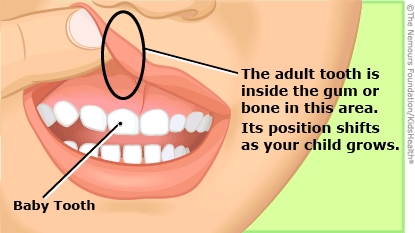Primary or "baby" teeth are a child's first set of teeth. They start to fall out when kids are around 6 years old. Then the permanent adult teeth come in over the next 15 years. Most baby tooth injuries don't need treatment. But some do to prevent damage to the adult teeth growing underneath them.
Use these instructions to care for your child and know what to watch for.


If your child injures the tooth again or gets another baby tooth injury, call your dentist right away. If you don't have a dentist or can't get in touch with yours, take your child to the emergency room (ER). Certain tooth injuries need treatment right away, even in baby teeth.
If you aren't sure if the tooth is a baby tooth or adult tooth, rinse it with milk or your child's saliva (spit) and gently place the tooth back into the gum socket where it came out. Then take your child to the dentist or ER right away.
If your child has a very loose, dangling baby tooth, ask your health care provider or dentist if you should pull it out or have them pull it out. Sometimes having a loose tooth is a choking risk if it falls out and a child breathes it in.

Your child:

What can happen from a baby tooth injury? Most baby tooth injuries don't cause any problems. But rarely, an injury can cause the adult tooth underneath it to come in stained, misshapen, or in the wrong position. This can happen from direct injury to the adult tooth or an infection at the root of the baby tooth that develops after the injury. Getting treatment right after a tooth injury makes these problems less likely to happen.
How are baby tooth injuries treated? If the tooth injury leaves a jagged edge, a dentist can sand it down. If the tooth is chipped, the dentist may reattach the chip or fill it in with a tooth-colored material. If a tooth comes out early and leaves a gap, the dentist may suggest a spacer to keep the rest of the teeth in place until the adult tooth comes in. A fake tooth can be attached to the spacer, if desired. More serious injuries (such as when the tooth gets pushed into the gum) may need a dental procedure, including possibly taking the tooth out.
What can help prevent tooth injuries? Young children like to explore their world, so not all tooth injuries can be prevented. But these steps can help: